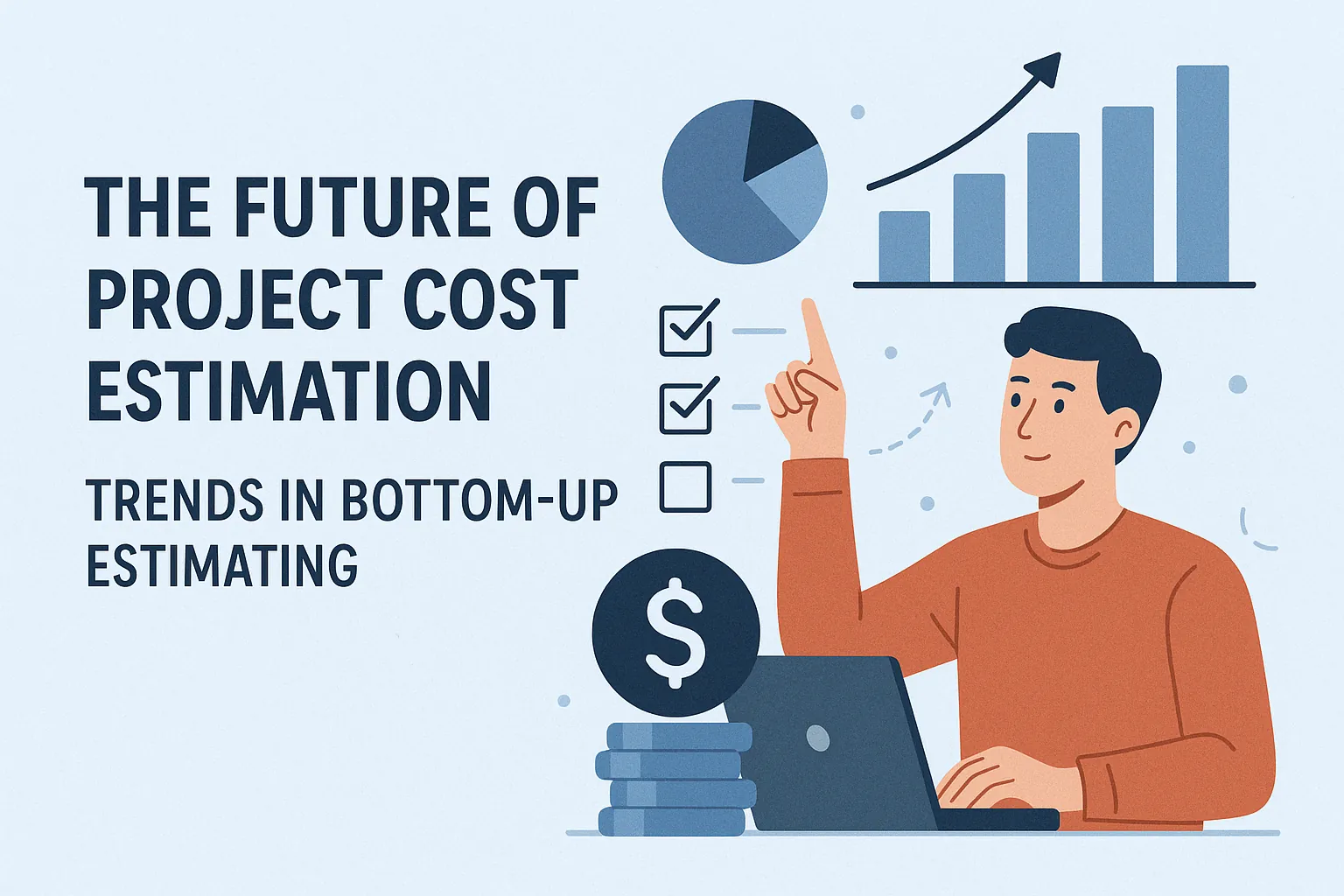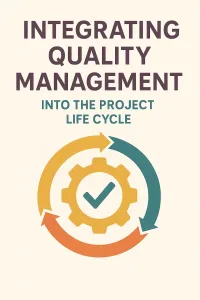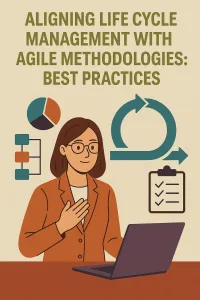Introduction to Bottom-Up Estimating
Accurate cost estimation is crucial for the successful execution and completion of projects. One of the most reliable methods for achieving this is bottom-up estimating. This technique involves breaking down a project into its smallest components, or work packages, and estimating the costs, time, and resources required for each individual task. These granular estimates are then aggregated to form a comprehensive total for the entire project. This method is significant because it provides a detailed and realistic view of project costs, allowing project managers to make informed decisions and allocate resources effectively [10][15].
Comparison with Top-Down Estimating
Bottom-up estimating stands in contrast to top-down estimating, where the overall project cost is determined first, and then divided among various components. While top-down estimating can be quicker and is often used in the early stages of project planning, it may lack the accuracy that bottom-up estimating offers. The choice between these two methods often depends on the project’s complexity and the availability of detailed information. For instance, bottom-up estimating is particularly beneficial in projects with well-defined tasks and requirements, while top-down estimating may be more suitable for projects with less clarity or when time constraints are a factor [12][13].
Traditional Methods of Bottom-Up Estimating
Historically, bottom-up estimating has relied on manual processes and spreadsheets, where project managers would list all tasks, estimate their costs, and then sum them up. This traditional approach, while effective, can be time-consuming and prone to human error. However, with the advent of modern technology, these methods are evolving. Project management software now allows for more efficient data collection and analysis, enabling project managers to create more accurate estimates with less effort. This shift not only enhances the accuracy of estimates but also streamlines the overall project planning process, making it easier for project management professionals to adapt to changing project dynamics [3][4][11].
The Role of Technology in Project Cost Estimation
In the evolving landscape of project management, the integration of technology has significantly transformed traditional estimating methods, particularly in bottom-up estimating. This section explores how modern advancements are reshaping the way project managers approach cost estimation, enhancing accuracy and efficiency.
Overview of Technological Advancements Influencing Project Management
The project management field has witnessed a surge in technological innovations that streamline processes and improve decision-making. Key advancements include:
- Cloud Computing: Facilitates real-time collaboration among project teams, allowing for immediate updates and access to project data from anywhere.
- Data Analytics: Provides insights through historical data analysis, enabling project managers to make informed estimates based on past project performances.
- Artificial Intelligence (AI): Enhances predictive analytics, allowing for more accurate forecasting of costs and timelines by analyzing patterns and trends in data.
These advancements not only improve the accuracy of estimates but also reduce the time required to compile and analyze data, making project management more agile and responsive.
Introduction to Software Tools and Platforms that Facilitate Bottom-Up Estimating
A variety of software tools and platforms have emerged to support bottom-up estimating, making the process more efficient and user-friendly. Some notable tools include:
- Project Management Software: Tools like Microsoft Project and Asana allow for detailed breakdowns of tasks and resources, enabling project managers to create comprehensive work breakdown structures (WBS) that are essential for bottom-up estimating.
- Cost Estimation Software: Specialized tools such as ProEst and CostOS provide templates and databases that help in estimating costs for individual tasks, streamlining the aggregation process.
- Collaboration Platforms: Tools like Trello and Slack enhance communication among team members, ensuring that all stakeholders are aligned and informed about project details, which is crucial for accurate estimating.
These platforms not only facilitate the bottom-up estimating process but also enhance collaboration and transparency among project teams.
The Shift from Manual Calculations to Automated Processes
The transition from manual calculations to automated processes marks a significant shift in project cost estimation. This evolution is characterized by:
- Increased Accuracy: Automated tools reduce human error associated with manual calculations, leading to more reliable estimates.
- Time Efficiency: Automation speeds up the estimation process, allowing project managers to focus on strategic planning rather than tedious calculations.
- Scalability: Automated systems can handle larger datasets and more complex projects, making them suitable for organizations of all sizes.
As project management continues to embrace technology, the bottom-up estimating method is becoming more sophisticated, allowing professionals to deliver projects on time and within budget with greater confidence.
Current Trends in Bottom-Up Estimating
The landscape of project cost estimation is evolving rapidly, driven by advancements in technology and a shift towards more collaborative and data-driven approaches. Bottom-up estimating, a method that involves breaking down projects into smaller, manageable components to create detailed estimates, is being significantly reshaped by these trends. Here are some key points highlighting the current trends in bottom-up estimating practices:
- Integration of AI and Machine Learning: The incorporation of artificial intelligence (AI) and machine learning (ML) into estimating processes is revolutionizing how project managers approach cost estimation. These technologies enable the analysis of vast amounts of historical data, allowing for more accurate predictions and insights. According to a McKinsey study, AI could enhance construction productivity by up to 20% through improved project planning and resource allocation, which directly benefits bottom-up estimating practices by providing more reliable data inputs [4].
- Use of Data Analytics for Improved Accuracy and Reliability: Data analytics is becoming a cornerstone of effective project management, particularly in the realm of cost estimation. By leveraging advanced analytics, project managers can identify patterns and trends from past projects, leading to more precise estimates. Deloitte reports that AI and advanced data analytics could yield cost savings of 10% to 15% for construction projects, underscoring the importance of data-driven decision-making in bottom-up estimating [8]. This trend not only enhances the accuracy of estimates but also builds confidence among stakeholders regarding project budgets.
- Rise of Collaborative Estimating Tools: The emergence of collaborative estimating tools is transforming team dynamics in project management. These tools facilitate real-time collaboration among team members, allowing for collective input and feedback during the estimating process. This collaborative approach not only improves the quality of estimates but also fosters a sense of ownership and accountability among team members. As project management increasingly emphasizes agility and flexibility, the ability to work together seamlessly on estimates becomes crucial [10]. The integration of generative AI tools, such as chatbots, further enhances this collaboration by streamlining communication and information sharing [5].
Benefits of Modernizing Bottom-Up Estimating
The adoption of modern technologies is significantly transforming traditional estimating methods, particularly bottom-up estimating. This approach, which involves breaking down projects into smaller, manageable components for detailed cost and duration estimation, is becoming increasingly efficient and accurate due to technological advancements. Here are some key benefits of modernizing bottom-up estimating:
- Increased Accuracy and Reduced Errors: Modern tools and software enhance the precision of cost estimations by allowing project managers to utilize historical data and analytics. By leveraging data from previous projects, teams can create more reliable estimates, minimizing the risk of budget overruns and ensuring that resources are allocated effectively. This accuracy is crucial for successful project management, as it directly impacts the overall project outcome and stakeholder satisfaction [5][6].
- Enhanced Speed of the Estimation Process and Project Planning: The integration of technology streamlines the estimation process, significantly reducing the time required to generate estimates. Automated tools can quickly analyze various project components, allowing project managers to focus on strategic planning rather than manual calculations. This efficiency not only accelerates project timelines but also enables teams to respond swiftly to changes and adapt their plans accordingly [12][14].
- Improved Stakeholder Communication and Transparency in Project Costs: Modern estimating tools facilitate better communication among stakeholders by providing clear and accessible cost breakdowns. With enhanced visualization and reporting capabilities, project managers can present estimates in a way that is easily understood by all parties involved. This transparency fosters trust and collaboration, as stakeholders are kept informed about project costs and any potential changes throughout the project lifecycle [8][15].
Challenges and Considerations
The adoption of bottom-up estimating practices is increasingly influenced by modern technology. However, several challenges and considerations must be addressed to ensure successful implementation. Here are some key points to consider:
- Resistance to Change: Many project managers are accustomed to traditional estimating methods, which can lead to reluctance in adopting bottom-up estimating techniques. This resistance often stems from a comfort with established processes and a fear of the unknown. Overcoming this inertia requires strong leadership and a clear communication strategy that highlights the benefits of modern estimating practices, such as increased accuracy and better resource allocation [6][12].
- Training and Skill Development: The integration of new technologies into bottom-up estimating necessitates a workforce that is well-versed in these tools. Project managers and team members may require extensive training to effectively utilize advanced estimating software and methodologies. This training is crucial not only for understanding the tools but also for fostering a culture of continuous improvement and adaptability within project teams [10][15]. Organizations must invest in skill development programs to bridge the knowledge gap and empower their teams to leverage these technologies effectively.
- Data Security and Privacy Concerns: The shift towards cloud-based estimating tools raises significant data security and privacy issues. Project managers must be vigilant about protecting sensitive project information from potential breaches. This concern is particularly pertinent in industries where confidentiality is paramount. Implementing robust security measures and ensuring compliance with data protection regulations are essential steps in mitigating these risks. Additionally, project managers should conduct thorough assessments of the security protocols of any cloud-based tools they consider adopting [4][8].
Case Studies: Success Stories in Bottom-Up Estimating
The integration of modern technology into traditional estimating methods, particularly bottom-up estimating, has proven to be transformative. This section highlights organizations that have successfully adopted technology-driven bottom-up estimating practices, showcasing their achievements and the lessons learned.
Profiles of Organizations
Construction Firm A:
- Overview: A mid-sized construction company specializing in commercial projects.
- Transition: Implemented a cloud-based project management software that integrates bottom-up estimating with real-time data analytics.
- Outcome: The firm reported a 20% reduction in project costs due to more accurate estimates and better resource allocation.
Tech Company B:
- Overview: A technology firm focused on software development.
- Transition: Adopted agile project management tools that allow for iterative bottom-up estimating, enabling teams to adjust estimates based on ongoing feedback.
- Outcome: The company experienced a 30% increase in project delivery speed, as teams could quickly adapt to changes and refine their estimates.
Engineering Firm C:
- Overview: An engineering consultancy that handles large-scale infrastructure projects.
- Transition: Utilized advanced modeling software to break down projects into smaller components, facilitating detailed bottom-up estimates.
- Outcome: Achieved a 15% increase in project profitability by minimizing unforeseen costs and enhancing budget accuracy.
Key Takeaways and Lessons Learned
- Embrace Technology: Organizations that successfully transitioned to technology-driven bottom-up estimating emphasized the importance of adopting modern tools. These tools not only streamline the estimating process but also enhance collaboration among team members, leading to more accurate forecasts [2][8].
- Continuous Improvement: The iterative nature of bottom-up estimating, especially in agile environments, allows for continuous refinement of estimates. This adaptability is crucial in dynamic project settings where requirements may change frequently [3][12].
- Training and Development: Investing in training for project teams on new estimating tools and methodologies is essential. Organizations that prioritized staff development saw improved adoption rates and better utilization of technology [5][6].
Impact on Project Outcomes
- Cost Savings: The case studies indicate significant cost savings as a direct result of implementing technology-driven bottom-up estimating. By breaking projects into smaller, manageable components, organizations were able to identify potential cost overruns early and adjust accordingly [1][6].
- Increased Efficiency: The integration of modern estimating practices led to enhanced efficiency in project execution. Teams reported faster decision-making processes and improved communication, which contributed to timely project completions [4][9].
- Enhanced Accuracy: With detailed estimates derived from a comprehensive breakdown of project components, organizations experienced a marked improvement in budget accuracy. This not only helps in securing stakeholder confidence but also in maintaining project profitability [2][8].
Future Outlook: The Evolution of Bottom-Up Estimating
The method of bottom-up estimating is also undergoing significant transformation, driven largely by advancements in technology. This section explores the future of bottom-up estimating, highlighting key trends and predictions that project management professionals should consider.
Predictions on Emerging Technologies
- Integration of Artificial Intelligence (AI): AI is poised to revolutionize bottom-up estimating by automating the breakdown of projects into smaller components. This will enhance accuracy and efficiency, allowing project managers to focus on strategic decision-making rather than manual calculations. AI can analyze historical data from previous projects to provide more precise estimates, reducing the risk of over-estimation that often occurs with traditional methods [7][8].
- Utilization of Big Data: The increasing availability of big data will enable project managers to make more informed decisions. By analyzing vast amounts of data from various projects, professionals can identify patterns and trends that inform better estimating practices. This data-driven approach will lead to more reliable estimates and improved project outcomes [9].
- Cloud-Based Collaboration Tools: The rise of cloud technology facilitates real-time collaboration among project teams, regardless of geographical location. This will enhance the bottom-up estimating process by allowing team members to contribute their insights and expertise directly into the estimating framework, leading to more comprehensive and accurate estimates [10].
The Role of Continuous Learning and Adaptation
Continuous learning and adaptation are crucial. Project management professionals must stay abreast of new tools, techniques, and methodologies that can enhance bottom-up estimating. This includes:
- Training and Development: Organizations should invest in training programs that focus on the latest technologies and estimating techniques. This will empower project managers to leverage new tools effectively and adapt their estimating practices accordingly [6].
- Feedback Loops: Implementing feedback mechanisms within project teams can foster a culture of continuous improvement. By regularly reviewing estimating practices and outcomes, teams can identify areas for enhancement and adapt their approaches to better meet project demands [5].
Embracing Innovation
To thrive in the future of project management, professionals must embrace innovation in their estimating practices. This involves:
- Open-Mindedness to New Tools: Project managers should be willing to explore and adopt new technologies that can streamline the estimating process. This includes experimenting with software solutions that integrate AI and big data analytics [4][9].
- Collaboration and Knowledge Sharing: Encouraging collaboration among team members and sharing knowledge about best practices can lead to more effective bottom-up estimating. By fostering an environment where innovation is celebrated, organizations can enhance their project management capabilities [3][10].
Conclusion
In the ever-evolving landscape of project management, bottom-up estimating has emerged as a crucial technique for accurately forecasting project costs and durations. This method, which involves breaking down projects into smaller, manageable components and estimating each individually, allows for a comprehensive understanding of the project’s scope and requirements. As project complexity increases, the significance of bottom-up estimating becomes even more pronounced, providing a reliable foundation for resource allocation and scheduling decisions [1][11].
The evolution of bottom-up estimating has been significantly influenced by advancements in technology. Modern tools and software have streamlined the estimating process, enabling project managers to gather data more efficiently and enhance the accuracy of their forecasts. These innovations not only facilitate better planning but also allow for real-time adjustments as project parameters change, ensuring that estimates remain relevant throughout the project lifecycle [3][12].
As we look to the future, it is imperative for project management professionals to embrace these technological advancements. By integrating modern estimating tools and techniques into their practices, they can improve their project outcomes and maintain a competitive edge in the industry. The shift towards technology-driven estimating methods is not just a trend; it is a necessary adaptation to meet the demands of increasingly complex projects [7][14].
In conclusion, project management professionals are encouraged to proactively explore and adopt modern estimating methods. By doing so, they can enhance their project planning capabilities, improve accuracy in cost estimation, and ultimately drive project success in an ever-changing environment. Embracing these innovations will not only benefit individual projects but also contribute to the overall advancement of the project management discipline [8][15].
Find out more about Shaun Stoltz https://www.shaunstoltz.com/about/.
This post was written by an AI and reviewed/edited by a human.



